Matt McCaffrey has an interesting post on incentives over at the Mises Economics Blog. He writes:
Nevertheless, emphasizing incentives too much glosses over several problems: economic laws can make incentives irrelevant; incentives are in any case too narrow a concept to be the defining characteristic of economics; focus on incentives sometimes leads to a paternalistic view of economic policy.
I like where he’s headed here. I’ve had similar skepticism of incentive talk myself, which I’ve expressed on this blog (archived here). But I have a few issues with the way he presents this issue:
1. Just because incentive talk might lead to a paternalistic view of economic policy doesn’t mean it’s not worth keeping around. If we can learn things from thinking and talking about incentives, we shouldn’t avoid doing it. The paternalistic tendencies of incentive talk is just an unfortunate side-effect–one we should combat with ideas, not ignorance or prohibition.
An analogy here might be the way playing games like SimCity or Age of Empires (one of my personal favorites) contributes to command-and-control-type thinking about economic resources. In these games, players are dictators and can achieve economic success for their digital world by more or less controlling how these worlds’ people use resources. Of course, the digital people aren’t real or rational, but the point is that these games can lead players to think about economies in terms of how central controllers can use force to maximize national output.
This is an unfortunate side-effect of such games, but that doesn’t mean they aren’t worth playing or that we should avoid them. We just need to be sure we keep our heads on straight with regard to how they fail to recreate real-world economic conditions.
2. The biggest problem with incentive talk is none of the objections McCaffrey raises above, but the fact that we cannot be sure of how people respond to incentives. We can only guess based on our observations of people’s demonstrated preferences. We cannot logically deduce our way to any conclusions about how people will respond to incentives except under hypothetical, ceteris paribus conditions. This is because costs are subjective.
This means that the extent of incentive talk’s usefulness is to understand the fact that people do indeed respond to incentives. We can’t be much more specific than that. Sure, we can make predictions that on the margin, ceteris paribus policy X will result in such and such an effect. For example, raising unemployment benefits will lead more people to become unemployed or remain unemployed longer. But we can’t really know this for sure. Like I said above, costs are subjective. Raising unemployment benefits lowers the financial cost of being unemployed, but we can’t know what other incentives are at play.
For example, I can conceive of a society where sending your children to public school is generally seen as a failure (on the part of parents) because people generally look down upon dependency on government. If government were to lower the cost of public schooling (it’s free, so this would mean something like paying parents to send their kids to public school), then, the net effect might be a reduction in the number of children going to public school. Parents, of course, face the financial incentive to send their kids to public school, but they also face the other incentive of avoiding the stigma associated with sending their kids to public school.
Incentives aren’t always financial, which leads me to a related point on incentives that I thought about last night.
During class the other day (I’m at George Mason University pursuing an MA in Economics), my professor offhandedly criticized the idea that we can effect any positive change via the democratic process because politicians simply respond to incentives like everyone else. They aren’t demigods. They aren’t any less susceptible to responding to financial incentives that encourage them to take actions other than what’s best for the long-term well-being of their constituency.
But isn’t it possible that a politician might not respond to such incentives, and instead respond to incentives that reward him for taking his constituency’s long-term well-being into consideration with every vote? I can think of a few politicians that don’t respond to financial incentives from lobbyists and interest groups because they care more about long-term economic stability than short-term financial gain.
Maybe I can sum this all up this way: Policy changes alter incentives, which affects people’s behavior on the margin. But we can never be sure whether that margin is big enough that anyone falls into it, or that other changes to incentive structures–ones we might not think of, and can never always consider all of the time–don’t offset or even outweigh the changes in behavior we do predict.
My thoughts on incentives are somewhat jumbled. I’m thinking about writing a more formal piece on this topic. I’ll let you know if I find the time to do so.


